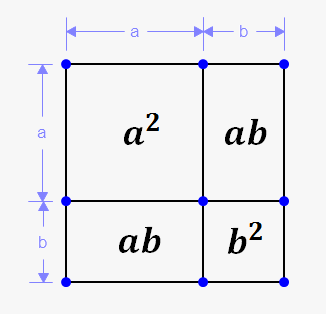Square of Sum and Difference
Square of sum and difference:
$$$\color{purple}{\left(a\pm b\right)^2=a^2\pm 2ab+b^2}$$$
Let's see how to derive it.
Recall, that exponent is just repeating multiplication.
Thus, we can write that $$${{\left({a}+{b}\right)}}^{{2}}={\left({a}+{b}\right)}{\left({a}+{b}\right)}$$$.
Now, apply FOIL: $$${\left({a}+{b}\right)}{\left({a}+{b}\right)}={a}\cdot{a}+{a}\cdot{b}+{b}\cdot{a}+{b}\cdot{b}={{a}}^{{2}}+{2}{a}{b}+{{b}}^{{2}}$$$.
 Similarly, it can be shown, that $$${{\left({a}-{b}\right)}}^{{2}}={{a}}^{{2}}-{2}{a}{b}+{{b}}^{{2}}$$$.
Similarly, it can be shown, that $$${{\left({a}-{b}\right)}}^{{2}}={{a}}^{{2}}-{2}{a}{b}+{{b}}^{{2}}$$$.
Or, more shortly: $$${{\left({a}\pm{b}\right)}}^{{2}}={{a}}^{{2}}\pm{2}{a}{b}+{{b}}^{{2}}$$$.
Geometrically $$${{\left({a}+{b}\right)}}^{{2}}$$$ represents an area of the square with side $$${a}+{b}$$$.
But, as shown on picture, this square consist of four smaller squares with areas $$${{a}}^{{2}}$$$, $$${a}{b}$$$, $$${a}{b}$$$, $$${{b}}^{{2}}$$$.
Thus, $$${{\left({a}+{b}\right)}}^{{2}}={{a}}^{{2}}+{a}{b}+{a}{b}+{{b}}^{{2}}={{a}}^{{2}}+{2}{a}{b}+{{b}}^{{2}}$$$.
Example 1. Multiply $$${{\left({2}{x}+{3}{y}\right)}}^{{2}}$$$.
Here $$${a}={2}{x}$$$ and $$${b}={3}{y}$$$.
Just use above formula: $$${{\left({2}{x}+{3}{y}\right)}}^{{2}}={{\left({2}{x}\right)}}^{{2}}+{2}\cdot{\left({2}{x}\right)}\cdot{\left({3}{y}\right)}+{{\left({3}{y}\right)}}^{{2}}={4}{{x}}^{{2}}+{12}{x}{y}+{9}{{y}}^{{2}}$$$.
Let's see how to handle minus sign.
Example 2. Multiply $$${{\left(\frac{{8}}{{3}}{a}{b}-{3}{c}{d}\right)}}^{{2}}$$$.
Here $$${a}=\frac{{8}}{{3}}{a}{b}$$$ and $$${b}={3}{c}{d}$$$.
Now, use formula for difference: $$${{\left(\frac{{8}}{{3}}{a}{b}-{3}{c}{d}\right)}}^{{2}}={{\left(\frac{{8}}{{3}}{a}{b}\right)}}^{{2}}-{2}\cdot{\left(\frac{{8}}{{3}}{a}{b}\right)}\cdot{\left({3}{c}{d}\right)}+{{\left({3}{c}{d}\right)}}^{{2}}=\frac{{64}}{{9}}{{a}}^{{2}}{{b}}^{{2}}-{16}{a}{b}{c}{d}+{9}{{c}}^{{2}}{{d}}^{{2}}$$$.
Finally, let's do a slightly harder example.
Example 3. Multiply the following: $$${{\left(-{x}{y}{z}-{5}{{x}}^{{2}}\right)}}^{{2}}$$$.
Till now, we didn't see two minus signs, but this case can be handled easily.
There are two options:
- $$${a}=-{x}{y}{z}$$$ and $$${b}=-{5}{{x}}^{{2}}$$$; apply sum formula.
- $$${a}=-{x}{y}{z}$$$ and $$${b}={5}{{x}}^{{2}}$$$; apply difference formula.
I choose second option: $$${{\left(-{x}{y}{z}-{5}{{x}}^{{2}}\right)}}^{{2}}={{\left(-{x}{y}{z}\right)}}^{{2}}-{2}\cdot{\left(-{x}{y}{z}\right)}\cdot{\left({5}{{x}}^{{2}}\right)}+{{\left({5}{{x}}^{{2}}\right)}}^{{2}}={{x}}^{{2}}{{y}}^{{2}}{{z}}^{{2}}+{10}{{x}}^{{3}}{y}{z}+{25}{{x}}^{{4}}$$$.
From last example we see, that $$${\color{purple}{{{{\left(-{a}-{b}\right)}}^{{2}}={{\left({a}+{b}\right)}}^{{2}}}}}$$$.
Another nice application of square of sum formula is to calculate square of a number. In many cases you can perform calculations mentally without calculator (or pen and paper).
Example 4. Calculate $$${{24}}^{{2}}$$$.
We could use calculator or multiply vertically, but there is simpler way.
We know, that $$${{20}}^{{2}}={400}$$$.
Thus, $$${{24}}^{{2}}={{\left({20}+{4}\right)}}^{{2}}={{20}}^{{2}}+{2}\cdot{20}\cdot{4}+{{4}}^{{2}}={400}+{160}+{16}={576}$$$.
Alternatively $$${{24}}^{{2}}={{\left({30}-{6}\right)}}^{{2}}={{30}}^{{2}}-{2}\cdot{30}\cdot{6}+{{6}}^{{2}}={900}-{360}+{36}={576}$$$.
Note, that this method is not always the simplest.
Now, it is time to exercise.
Exercise 1. Multiply $$${{\left({5}{z}+{3}{y}\right)}}^{{2}}$$$.
Answer: $$${25}{{z}}^{{2}}+{30}{z}{y}+{9}{{y}}^{{2}}$$$.
Exercise 2. Multiply $$${{\left(-\frac{{1}}{{3}}{x}{{y}}^{{2}}+{2}{x}\right)}}^{{2}}$$$.
Answer: $$$\frac{{1}}{{9}}{{x}}^{{2}}{{y}}^{{4}}-\frac{{4}}{{3}}{{x}}^{{2}}{{y}}^{{2}}+{4}{{x}}^{{2}}$$$.
Hint: either swap summands ($$${{\left(-\frac{{1}}{{3}}{x}{{y}}^{{2}}+{2}{x}\right)}}^{{2}}={{\left({2}{x}-\frac{{1}}{{3}}{x}{{y}}^{{2}}\right)}}^{{2}}$$$: commutative property of addition) or proceed as always.
Exercise 3. Multiply the following: $$${{\left(-{3}{x}-{2}\right)}}^{{2}}$$$.
Answer: $$${9}{{x}}^{{2}}+{12}{x}+{4}$$$.
Exercise 4. Calculate $$${{31}}^{{2}}$$$ using square of sum/difference formula.
Answer: $$${961}$$$. Hint: $$${{31}}^{{2}}={{\left({30}+{1}\right)}}^{{2}}$$$ or $$${{31}}^{{2}}={{\left({40}-{9}\right)}}^{{2}}$$$ (however, first option is easier).
